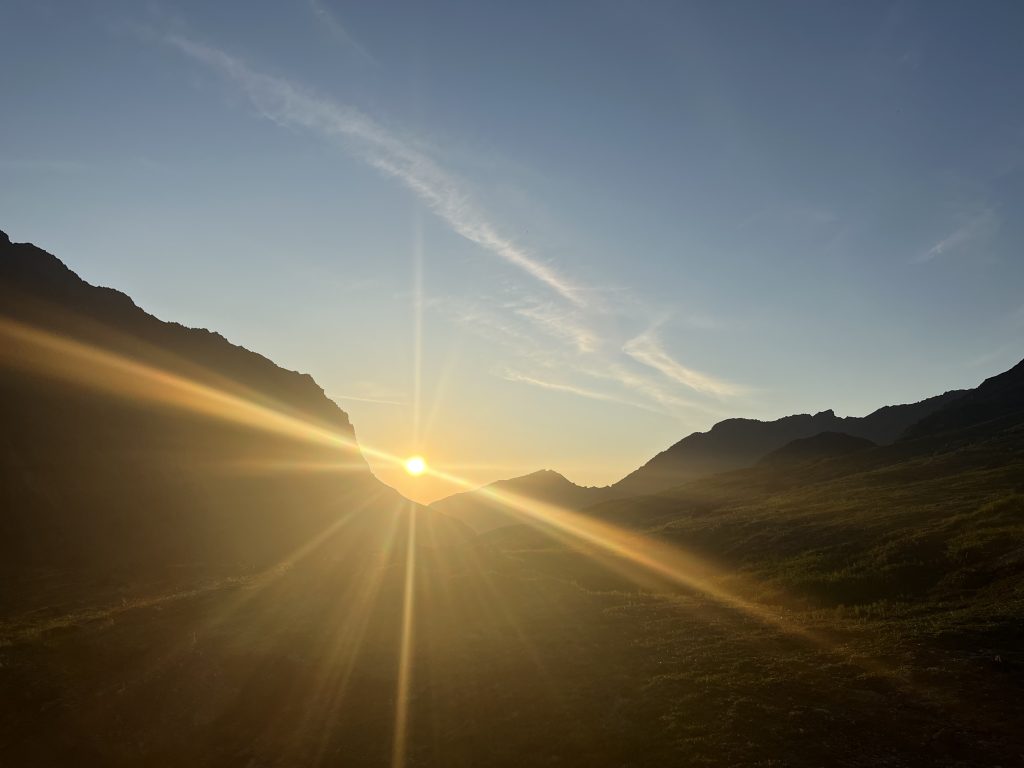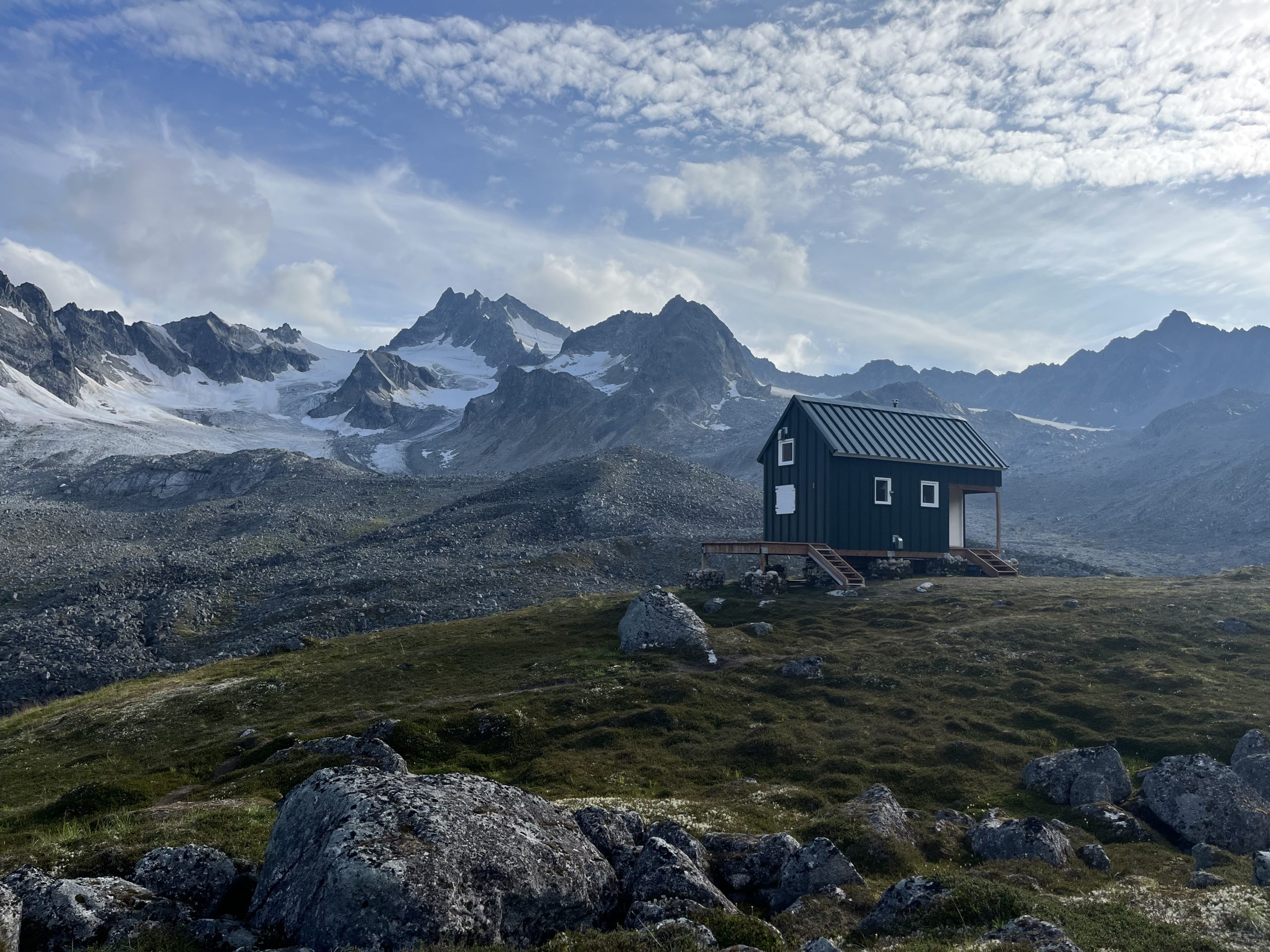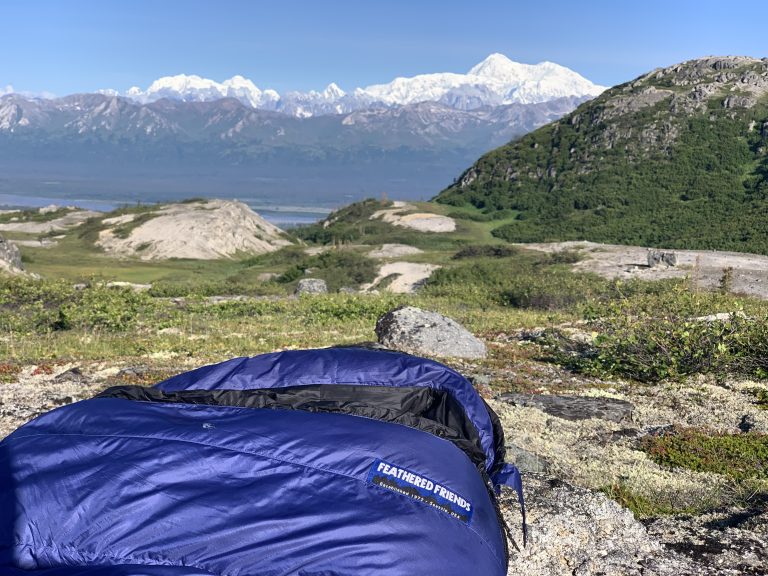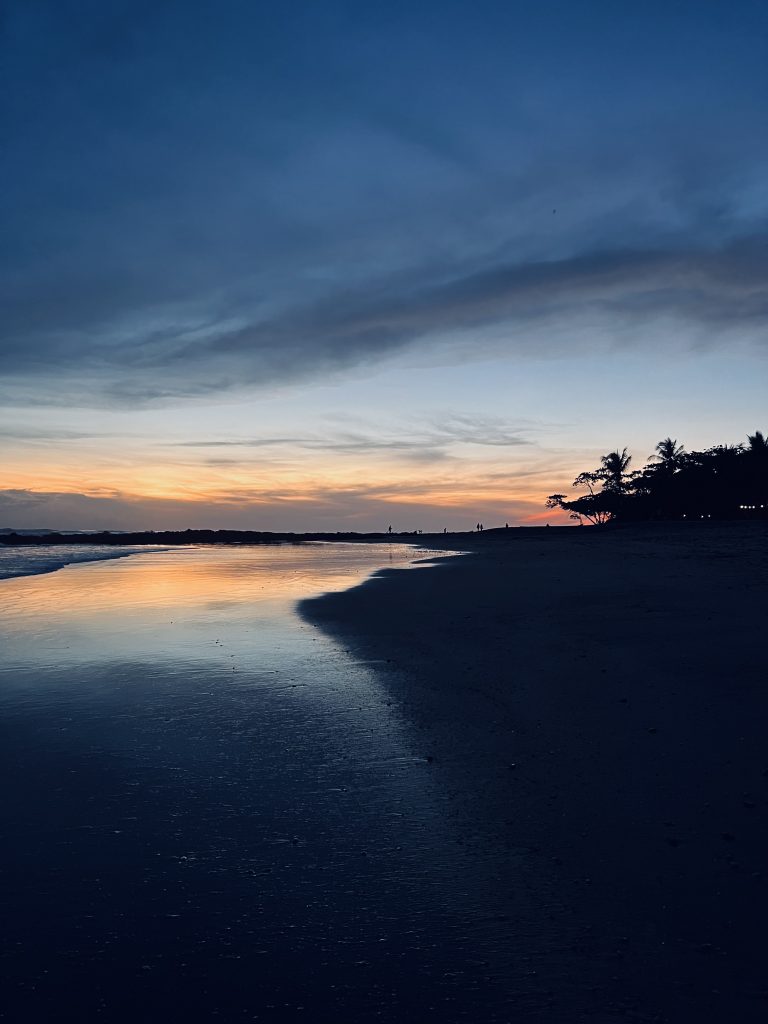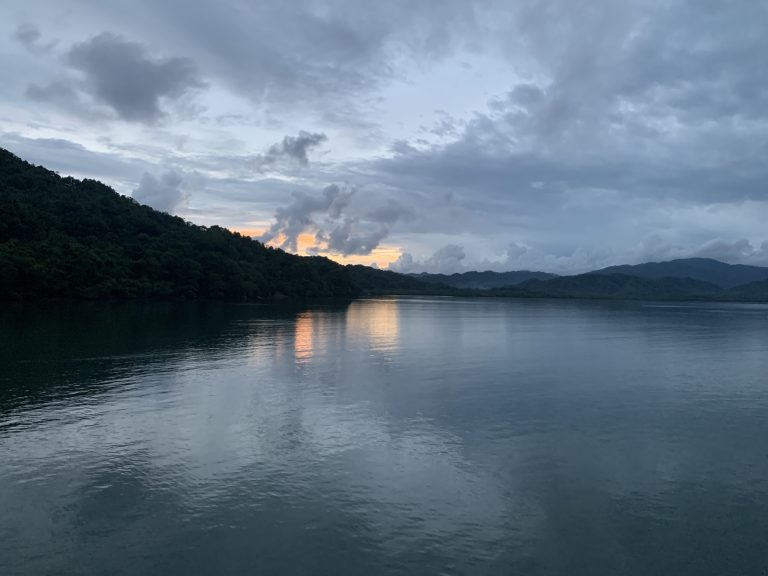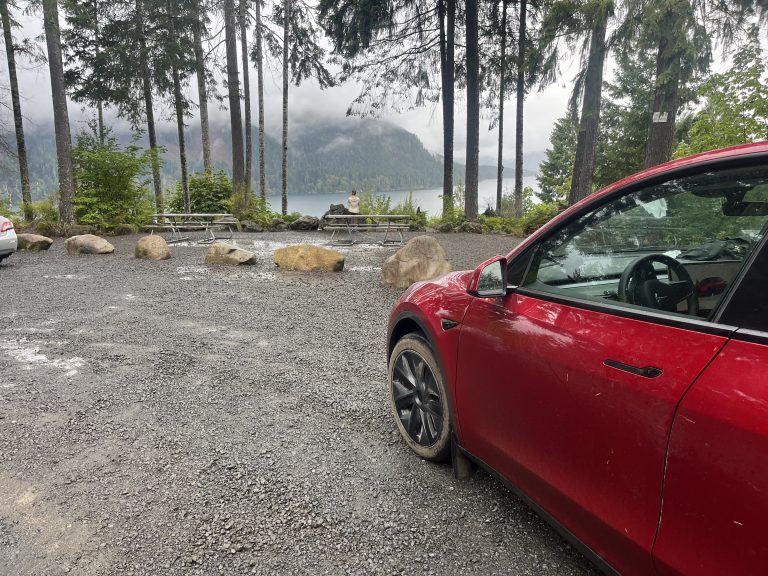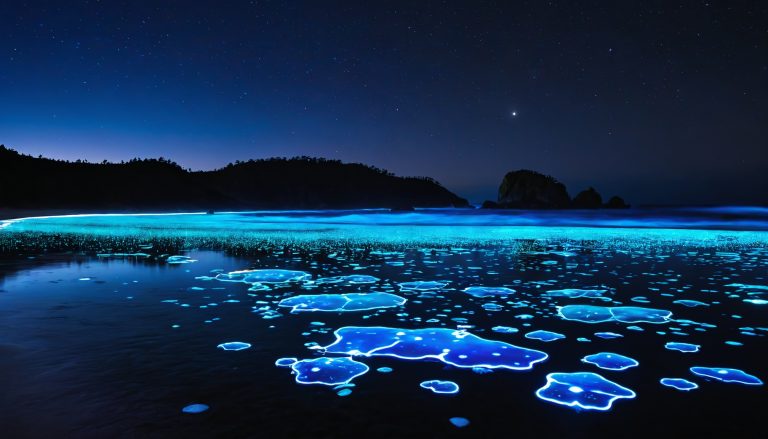There is no better way to start a conversation than to say you’re from Alaska. Following such an announcement there is usually a cascade of related questions. I love this. I love talking about Alaska. I love writing about Alaska. And most importantly, I love Alaska. Alaska is one of – if not the – most beautiful place I have ever been. It is rugged, expansive, harsh, pristine, and unforgiving.
If you are interested in visiting Alaska, particularly to go backpacking, this is the guide for you. Whether you’re a seasoned trekker or new to backcountry adventures, this guide will walk you through everything you need to know. From choosing the right gear to navigating wildlife encounters, we’ve got you covered. Did you know that over 50% of Alaska is designated wilderness? And most of it you can simply pitch a tent in.
Best Time of Year for Backpacking in Alaska
Alaska’s seasons are dramatic, harsh, and play a huge role in shaping your backpacking experience. Knowing when to go is essential for making the most of your trip. Our favorite time to visit is in August, as the mosquitoes tend to be less of a problem, the crowds start to thin out, and the weather remains generally pleasant.
It’s also important to recognize that depending on where you go in Alaska, the effects of the seasons will be more or less moderate. The general rule is that the more south and close the ocean you are, the more temperate the seasons. The more north and interior you go, the more extreme.
Summer (June to August):
Summer is the most popular time to visit Alaska for backpacking. With long daylight hours—often 18 to 24 hours of sunlight—and relatively mild temperatures, it’s the ideal season for tackling Alaska’s trails. However, summer also brings mosquitoes, higher crowds, and potential rain, especially in coastal areas. Do you like being able to hike at 2am amidst the most incredible sunsets you’ve ever seen? Then this is the time for you!
Also, note that because of the way that the sun sets in Alaska, sunrises and sunsets tend to be spectacularly long.

Important Note: In some mountain areas, June can still see trails covered in snow, especially in higher elevations. Be prepared for snowpack, even in early summer.
- Early August: Our favorite time to visit! It’s a great window to experience the best of Alaska’s wilderness without the heavy summer rush.
- Pros: Long days, warmer temperatures, fully accessible trails
- Cons: Crowds, mosquitoes, unpredictable rain
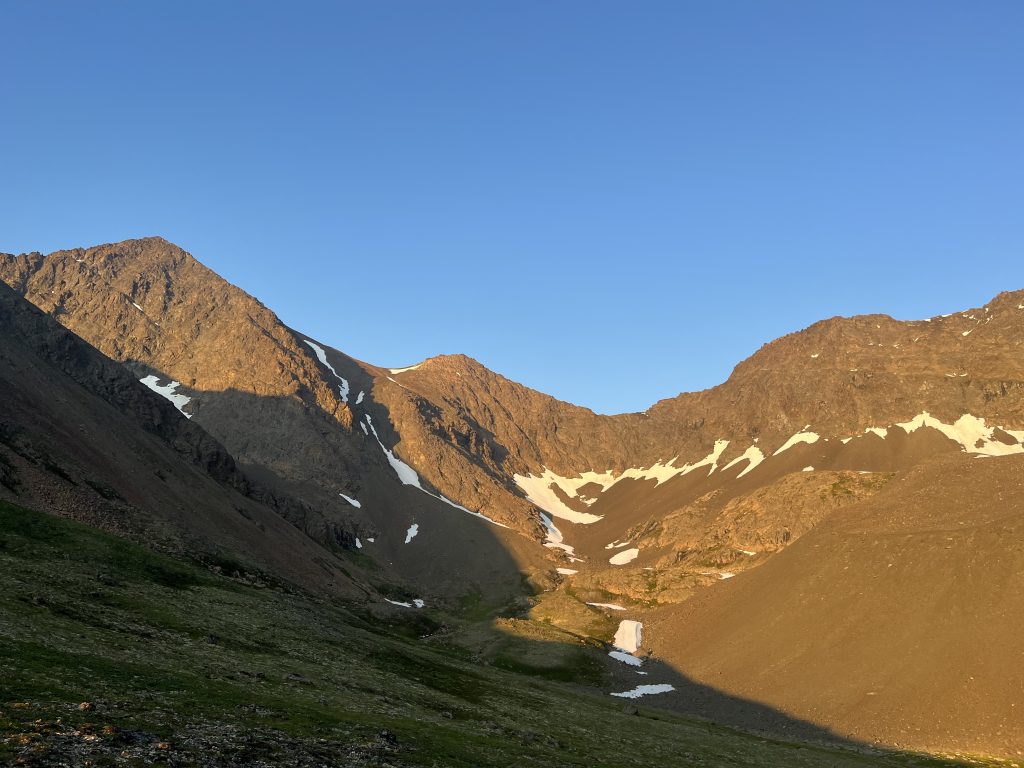
Fall (September):
Yeah, that’s it. One month. Fall in Alaska is short but brings stunning foliage and cooler weather. While many trails remain accessible, snow can start accumulating in higher elevations by late September. This season is great for those looking to avoid crowds, but be prepared for rapidly changing conditions – and dress warm!
- Pros: Fewer crowds, beautiful fall colors
- Cons: Early snow, shorter daylight hours, colder temps dropping close to freezing at night
Winter (November to March):
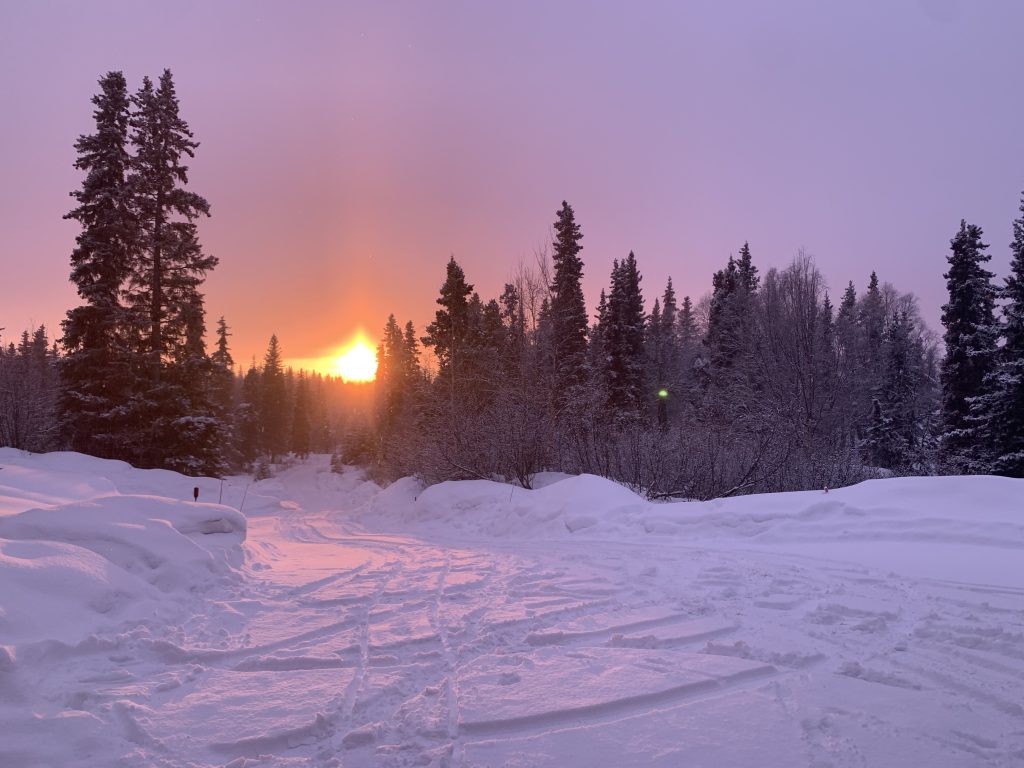
Winter in Alaska is harsh and only for the most experienced backpackers. While the idea of hiking under the northern lights might sound appealing, freezing temperatures, heavy snowfall, and extremely short daylight hours can make winter backpacking dangerous without the proper gear and preparation.
- Pros: Solitude, unique winter landscapes, northern lights
- Cons: Extreme cold, limited daylight, difficult navigation
Spring (April to May):
Spring is an unpredictable time in Alaska. Snow melts late in Alaska and can make trails muddy and rivers overflow, but as the weather starts to warm, it’s a beautiful time to explore before the summer rush begins. However, avalanche risk is very high during this period, especially in mountain areas, making it dangerous to head into higher elevations. Be cautious about venturing into the mountains in the spring.
Important Note: You likely won’t be able to go into the mountains due to the snow and avalanche risk. Always check local avalanche forecasts and plan accordingly.
- Pros: No crowds, blooming wildflowers
- Cons: Muddy trails, melting snow, avalanche risk, unpredictable weather
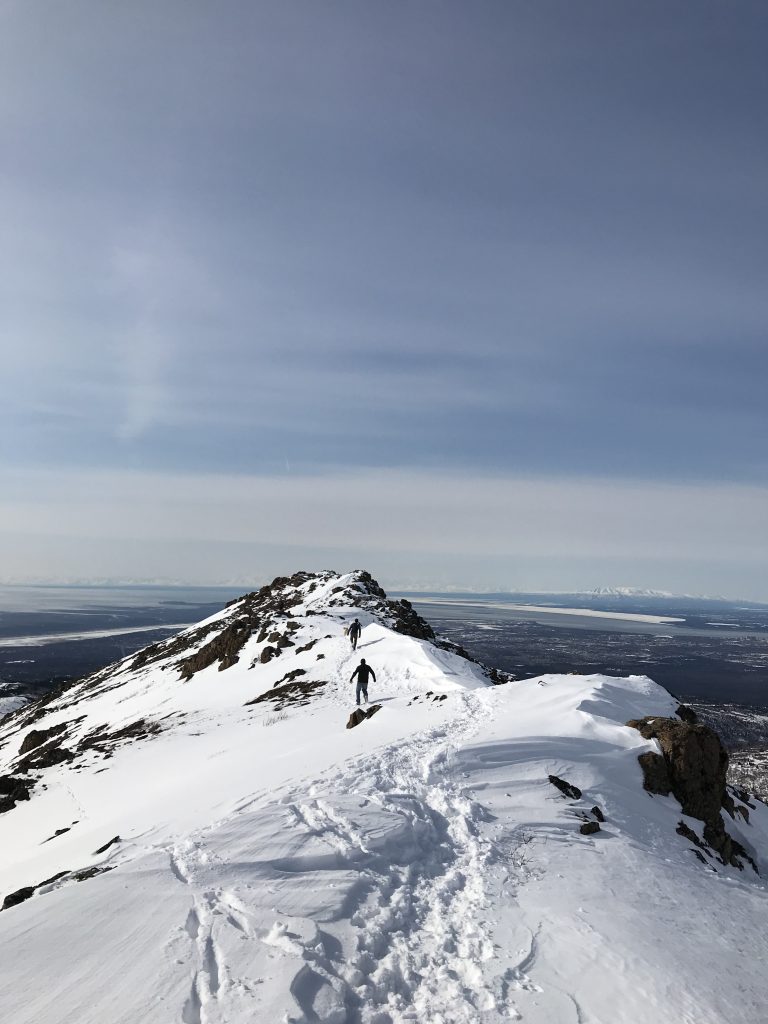
Where to Backpack in Alaska by Region
Alaska is enormous. Cut Alaska in half and Texas is the third largest state. Because of this, different regions offer entirely different experiences and even animals. It’s also very difficult to get around from one region to another without flying, so it’s best to choose one region to explore on your trip.
Recognize as well that the more north you go, the more the tree line (the elevation at which trees can grow) is close to sea level. For example, in south east Alaska, you have to hike to about 3000 feet to get above the trees. In Anchorage, it’s about 2000 feet. In the Arctic, it’s sea level (meaning there are no trees).
Southcentral Alaska
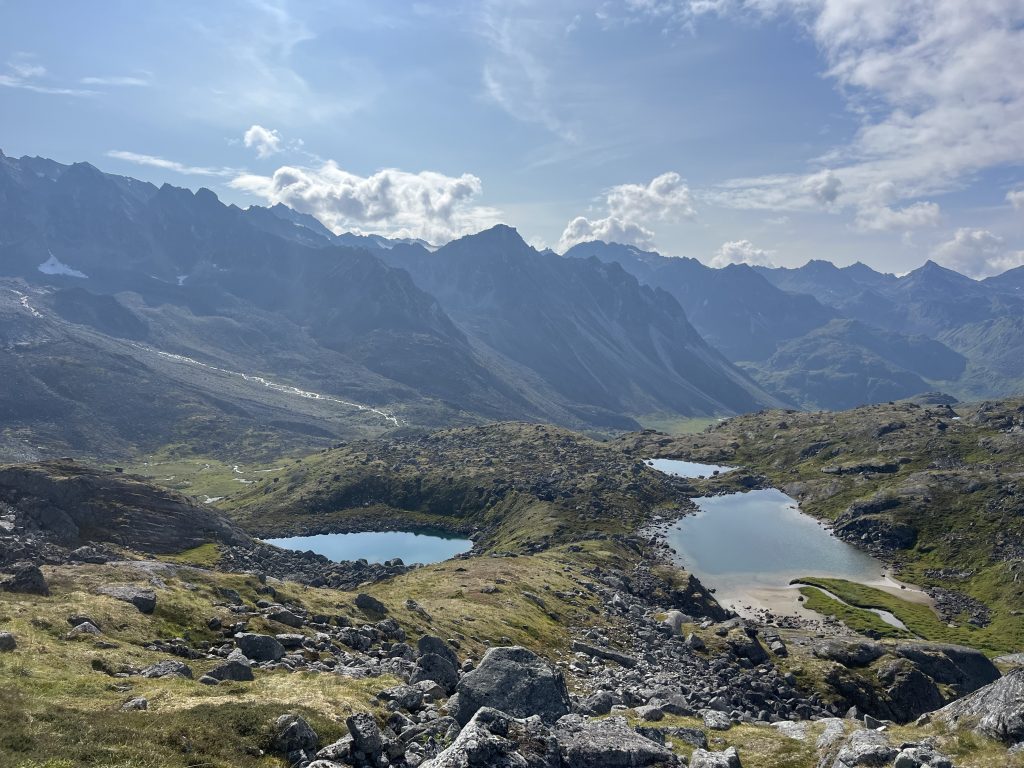
Southcentral Alaska offers a great mix of accessible trails; but it’s still Alaska so everything still feels remote. This is our recommendation if you’re looking for THE classic taste of Alaska. It’s my favorite place to visit. There are tons of peaks to bags, rivers to raft, and towns to explore. Also, because the tree line is fairly low, meaning you can easily get above trees when hiking to experience incredible views and long ridge line hikes.
You can also reach Denali from here but it takes about 5 hours (compared to 2 hours from Fairbanks).
- Nearby Cities and Sites:
- Anchorage: Where my family lives now, Anchorage is the largest city in Alaska and is a great jumping off point for backpacking and outdoor adventures. From Anchorage, you can easily access nearby trails like Crow Pass, explore the beautiful Chugach State Park, and visit the Talkeetna Mountains (my personal favorites).
- Seward and Homer: Home to Kenai Fjords National Park, quint towns, Alaskan artists, incredible drives, this area is a must-see for its spectacular glaciers and marine wildlife.
- McCarthy: One of my favorite off-the-beaten-track places in Alaska, McCarthy is an olt-timey town that can only be accessed via a walking bridge over a glacial river. Expect incredible views of Kennicott Glacier.
- Popular Trails: Crow Pass Trail, Bomber Glacier Traverse, Symphony Lakes, Little & Big O’Malley
- Best For: Stunning mountain views, glaciers, and easy access
- Considerations: Weather can be unpredictable, especially in the shoulder seasons.
Interior Alaska

Known for its extreme temperatures and terrible mosquitos, Fairbanks and the surrounding area is remote and pretty surprisingly flat. However, you can reach Denali from here (2 hour drive compared to 5 hours from Anchorage).
- Popular Trails: Denali National Park backcountry routes, Kesugi Ridge
- Best For: Remote, rugged wilderness and wildlife encounters
- Nearby Cities and Sites:
- Fairbanks: A major hub for the Interior, known for its midnight sun in the summer and the northern lights in winter. Fairbanks is a common launching point for expeditions into Denali or the Brooks Range.
- Denali National Park: Famous for Mount Denali (North America’s tallest peak), the park offers vast wilderness areas for backcountry exploration.
- North Pole: A quirky town near Fairbanks, popular for its year-round Christmas-themed attractions.
- Considerations: The Interior offers true wilderness experiences, but access can be challenging. Denali’s backcountry is for experienced backpackers who are ready for unpredictable weather and wildlife encounters like bears and moose.
Park Road Closure: Due to ongoing repairs related to landslides, the Denali Park Road is closed at Mile 43, limiting vehicle access further into the park. This closure is expected to remain in place through summer 2026.
Southeast Alaska
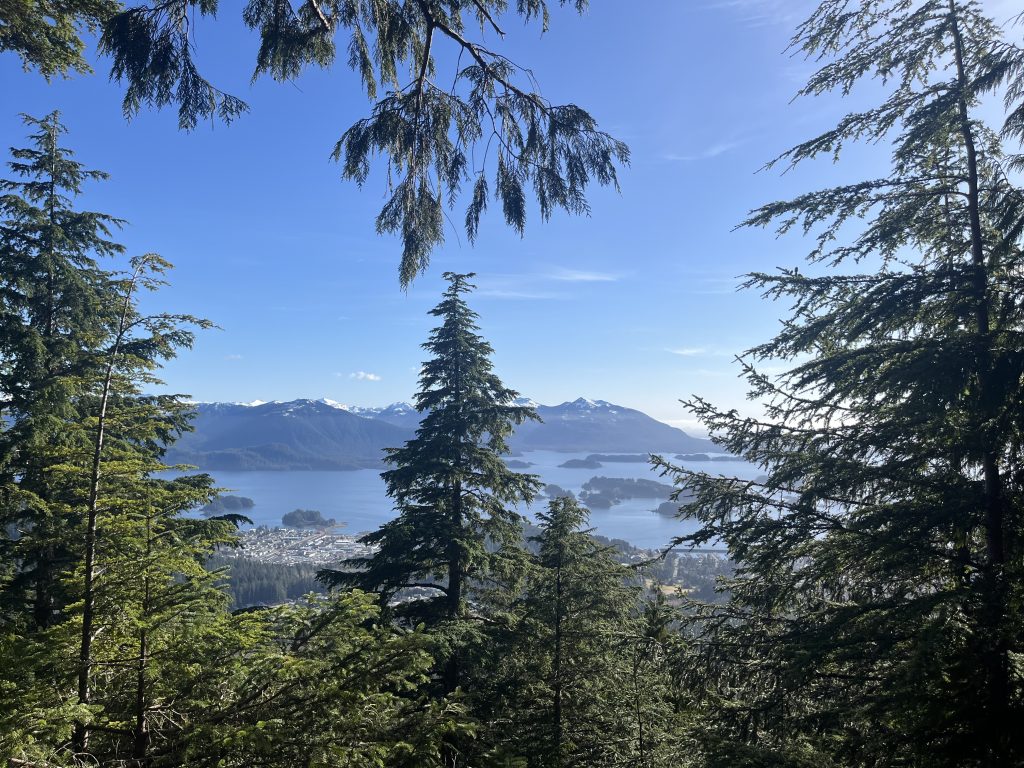
I grew up in Southeast Alaska, in Sitka. This area is a temperate rainforest and will remind you of Olympia National Park. Getting about 120 inches of rain a year (compared to Seattle which gets about 37 inches), this area is known for its lush old-growth forests, archipelagos of islands, diverse sea life, and glaciers. However, because of how lush the forests are, it’s much more difficult to just chart your own course through the wilderness, despite the numerous peaks in the area.
- Popular Trails: Tongass National Forest, Chilkoot Trail
- Best For: Coastal rainforests, historic trails, and glaciers
- Nearby Cities and Sites:
- Juneau: Alaska’s state capital, famous for the nearby Mendenhall Glacier and a starting point for exploring the Tongass National Forest.
- Skagway: Starting point for the Chilkoot Trail, a historic route used during the Klondike Gold Rush. Skagway also offers access to scenic train rides along the White Pass & Yukon Route.
- Sitka: A coastal town rich in Russian history and indigenous culture, offering access to the stunning landscapes of the Inside Passage.
- Considerations: Southeast Alaska is wet year-round, so pack waterproof gear. Sea kayaking, fishing, and whale watching is what this area is known for.
Southwest Alaska
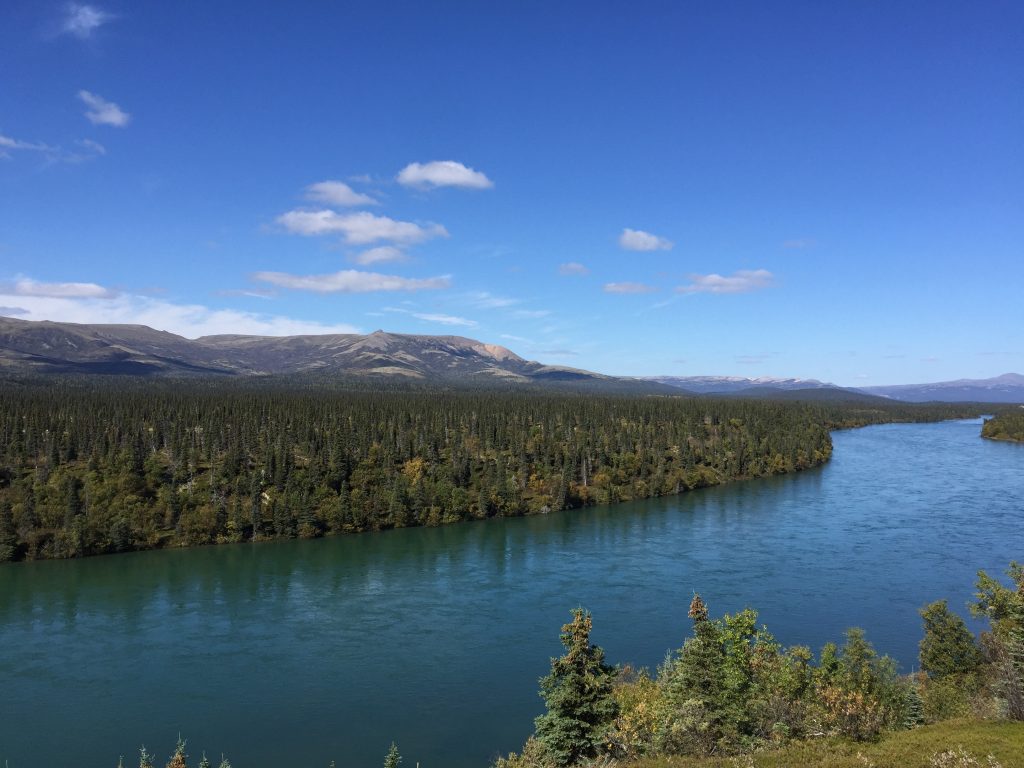
This is a very remote part of Alaska and one I have not ventured in much. However, if you want the wild of the wild, this is where you’ll find it. Most of the places here are native villages.
- Popular Trails: Katmai National Park, Lake Clark National Park
- Best For: Wildlife, including bears and salmon runs
- Nearby Cities and Sites:
- King Salmon: Gateway to Katmai National Park, famous for its brown bears that gather around Brooks Falls to catch salmon.
- Port Alsworth: A small town near Lake Clark National Park, known for its breathtaking scenery, remote lodges, and world-class fishing.
- Kodiak: Known for its large population of Kodiak brown bears, the island offers rugged hiking opportunities and a rich fishing industry.
- Considerations: Southwest Alaska requires more planning, as it’s remote and harder to access. It’s famous for bear-viewing, but the terrain can be challenging.
Far North/Arctic Alaska
I’ve been up here once. It’s extremely exotic, remote, and if you get in trouble out here, you’ll probably die. However, you’re hiking on the tundra, coming across fallen caribou antlers as you hike, and seeing herds and packs of caribou and wolves. Good luck. For those who want to venture forth into this unforgiving wildnerness, you’ll have to a bush plane – generally to Anaktuvuk Pass.
- Popular Trails: Gates of the Arctic, Brooks Range
- Best For: The ultimate wilderness experience, with minimal human impact
- Nearby Cities and Sites:
- Utqiaġvik (Barrow): The northernmost city in the United States, known for its extreme climate and traditional Iñupiat culture.
- Anaktuvuk Pass: A small, remote village in the Brooks Range, accessible by plane, and an excellent starting point for exploring the far north.
- Prudhoe Bay: Known for its oil fields and as the terminus of the Dalton Highway, Prudhoe Bay offers access to the Arctic Ocean.
- Considerations: Extremely remote, requires air transport, and only suitable for experienced backpackers. It’s one of the most remote and untouched regions in Alaska, offering an incredible opportunity for true wilderness exploration.
So Where Should I Go?
If you’re intending to backpack, I would recommend hitting Anchorage and Southcentral. If you are looking for fishing, kayaking, and ocean exploration, go to Southeast. If you want remote and extremely challenging, but absolutely one of a kind trips, visit either the Arctic or Southwest Alaska.
Renting a Car and Finding Accommodations in Alaska
Exploring Alaska’s vast wilderness requires some planning, especially when it comes to transportation and accommodations. While Alaska is famous for its rugged roads, generally, you don’t need a 4×4 vehicle if you’re visiting during the summer. Most main roads, including the Parks Highway and the Seward Highway, are well-maintained and can be navigated without four-wheel drive. However, if you’re traveling in the winter, you will definitely need a 4×4 vehicle to handle the icy roads and snowy conditions.
How To Rent a Car in Alaska During Summer
Renting a car in Alaska during the summer can be very difficult due to high demand, and availability often becomes an issue. Rental cars book up quickly, and prices can skyrocket. This is usually the biggest obstacle when visiting Alaska during the summer, especially if you’re booking last minute.
- Alternatives to Renting:
One option is to rent a car well in advance, but another alternative is to buy a used car from Craigslist or another local marketplace when you arrive in Alaska. This allows you to avoid the high rental fees, and at the end of your trip, you can resell the car—potentially saving money overall. I have successfully done this with some friends before.
Where To Stay in Alaska
Alaska offers a wide range of accommodations, from campgrounds and public-use cabins to hotels and lodges. Your choice will depend on the region you’re exploring and the level of comfort you’re looking for. If you’re looking for a more budget friendly option, I recommend getting yourself a car, and hitting many of the campgrounds along the way. Even during the summer, it’s fairly easy to find last minute spots at amazing campgrounds.
- Campgrounds:
Alaska is a backpacker’s paradise when it comes to camping. There are numerous state parks, national forests, and public lands that offer both designated campgrounds and opportunities for dispersed camping. In many areas, especially outside of the most popular parks, you can camp for free or for a small fee. Popular camping destinations include Denali National Park and the Kenai Peninsula. - Public-Use Cabins:
For those seeking a bit more shelter, public-use cabins are available for rent throughout Alaska’s state and national parks. These cabins are typically very basic, but they offer protection from the elements. Cabins are often booked months in advance, so early reservations are crucial, especially in popular spots like Kenai Fjords National Park or Chugach State Park. - Hotels and Lodges:
For a more comfortable stay, Alaska has plenty of hotels and lodges. Anchorage, Fairbanks, Juneau, and other larger towns offer a variety of hotels for different budgets. For a more unique experience, consider staying at a wilderness lodge. These lodges are often located in remote areas and offer access to the surrounding wilderness for activities like fishing, hiking, and wildlife viewing.
Best Off The Beaten Track Places To Stay in Alaska
- Hatcher’s Pass Cabins: Located near the Hatcher Pass recreation area, these cabins offer stunning views of the Talkeetna Mountains and easy access to hiking trails. Learn more at Hatcher’s Pass Lodge.
- Le Barn Appetite in Seward: This charming bed and breakfast in Seward is well-known for its fantastic crepes and cozy accommodations. Check it out at Le Barn Appetite.
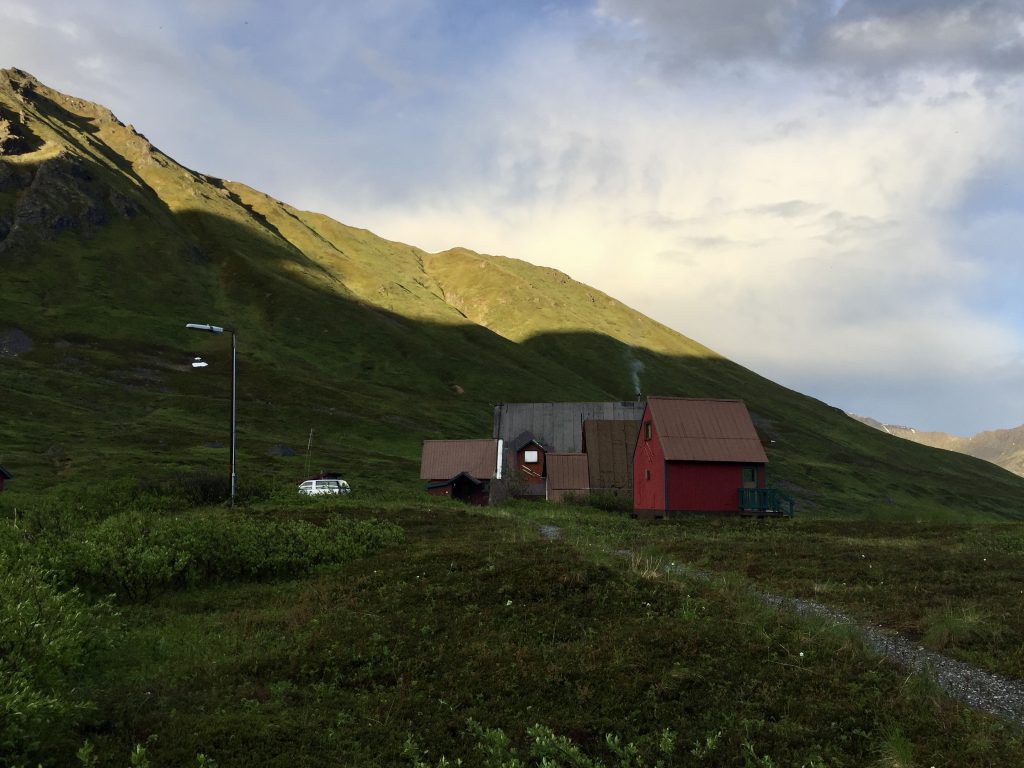
Additional Tips for Accommodation and Travel
- Seasonality: Many accommodations, particularly campgrounds and lodges, operate seasonally and may only be open from May to September, depending on weather conditions.
- Reservations: Whether you’re camping, booking a cabin, or staying in a hotel, it’s best to make reservations as early as possible during the peak summer season to ensure availability. However, if you’re like me and never plan too far in advance, you can still get by last minute, as long as you’re flexible.
Cost of Backpacking in Alaska
Backpacking in Alaska is epic, but it’s certainly not the cheapest option. While Alaska offers incredible opportunities for free or low-cost camping, other expenses such as transportation, permits, and accommodations can add up quickly. Here’s a breakdown of the typical costs you can expect while backpacking in Alaska:
Transportation Costs
Flights
If you’re flying into Alaska from the lower 48 states, round-trip flights to major cities like Anchorage or Fairbanks typically range from $300 to $600, depending on the season. Prices are higher during the peak summer months, so booking early is key to securing cheaper rates.
Alaska Airlines offers great deals, and they have one of the best airline reward credit cards available. If you sign up for their credit card, you can get 60,000 bonus miles and access to the companion fare deal, which allows you to bring a companion for a small fee (as low as $99 plus taxes and fees). Their mileage flights to Alaska are some of the best deals available, making it an excellent choice for travelers looking to save on airfare.
Flying from Europe? If you’re flying from Europe, consider booking your flight through Frankfurt, which offers a direct flight to Anchorage that operates during the summer months.
Car Rentals
Renting a car can be one of the bigger expenses for your trip. Prices range from $70 to $150 per day for standard vehicles. During the summer, availability is limited, and costs rise, making it more important to book in advance or consider alternatives like buying and reselling a used vehicle (as mentioned in the car rental section).
Public Transportation and Hitchhiking
For those without a vehicle, buses and shuttles are available in certain areas but may have limited service. These options are often affordable but require planning to match schedules, especially when visiting remote parks. Hitchhiking, however, is an option and most places are fairly friendly to hitchhikers.
Accommodation Costs
Campgrounds
Staying at a campground is usually the most affordable option. Prices range from $10 to $30 per night, depending on the location and amenities. Many backcountry areas allow free camping, especially on BLM land and in remote regions like the Brooks Range.
Public-Use Cabins
If you prefer a bit more comfort, public-use cabins are available for about $50 to $100 per night, but these require advance reservations, especially during peak summer months.
Hotels and Lodges
For stays in towns like Anchorage, Fairbanks, or Juneau, hotel prices typically start at around $100 per night, with higher-end options costing significantly more.
Permit and Park Fees
- National Park Entrance Fees:
Most of Alaska’s national parks do not have entrance fees, but those that do, like Denali National Park, charge $15 per person for a 7-day pass. - Backcountry Permits:
While backcountry permits are generally free in Alaska’s national parks, some parks, like Denali and Katmai, have mandatory orientation sessions that may incur small fees.
Bear Protection
Bear safety is paramount in Alaska, and you’ll need a bear-proof container if you’re venturing into bear country. Renting a bear canister typically costs $5 to $10 per day. Since you can’t fly with bear spray, many people try to get rid of it at the end of their trip. You can usually get it for free, like with this facebook group.
Best Backpacking Trails in Alaska
While Alaska is filled with amazing trails, we’ve compiled our favorite backpacking routes from each region. For more detailed recommendations and guides, check out our specific regional guides to Alaska’s best backpacking routes.
Southcentral Alaska: Bomber Glacier Traverse
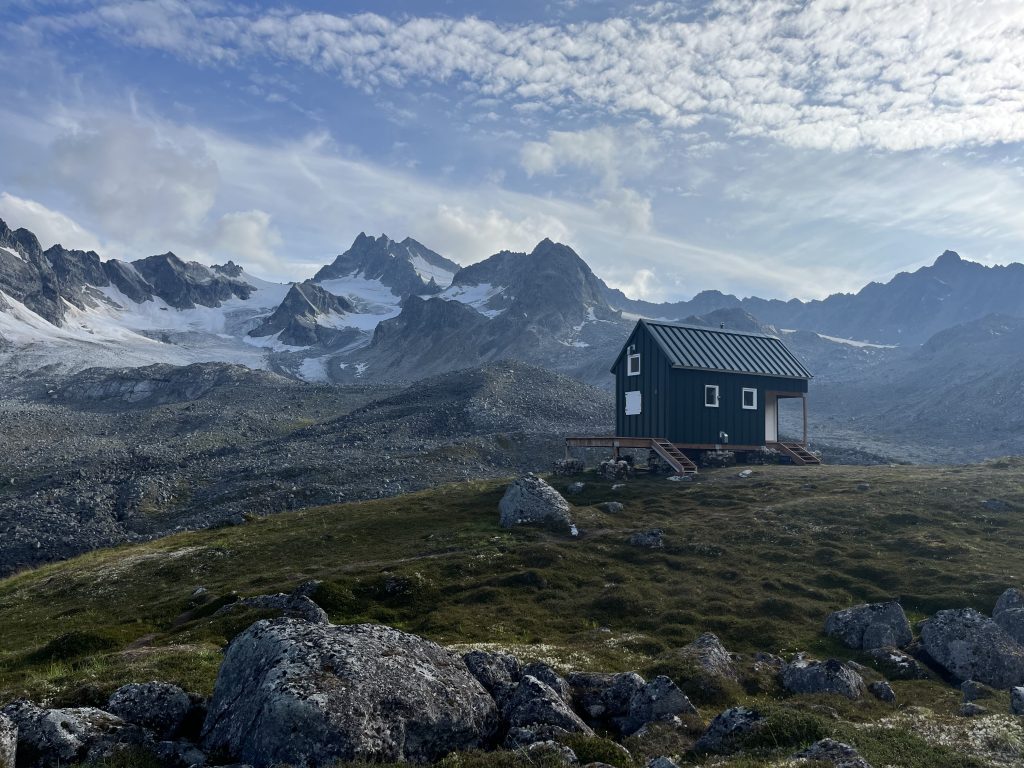
- Miles: 24 miles (round trip) – can vary depending on route
- Average Nights: 2–4 nights
- Difficulty: Strenuous
- Overview: The Bomber Glacier Traverse is the most incredible backpacking route in Alaska (in my opinion), but this trek through Talkeetna Mountains is not for the faint of heart. You’ll need solid route-finding skills and preparation for steep climbs and glacier crossings. This trail offers incredible views of alpine terrain, lakes, alpine cabins, and glaciers.
Interior Alaska: Kesugi Ridge
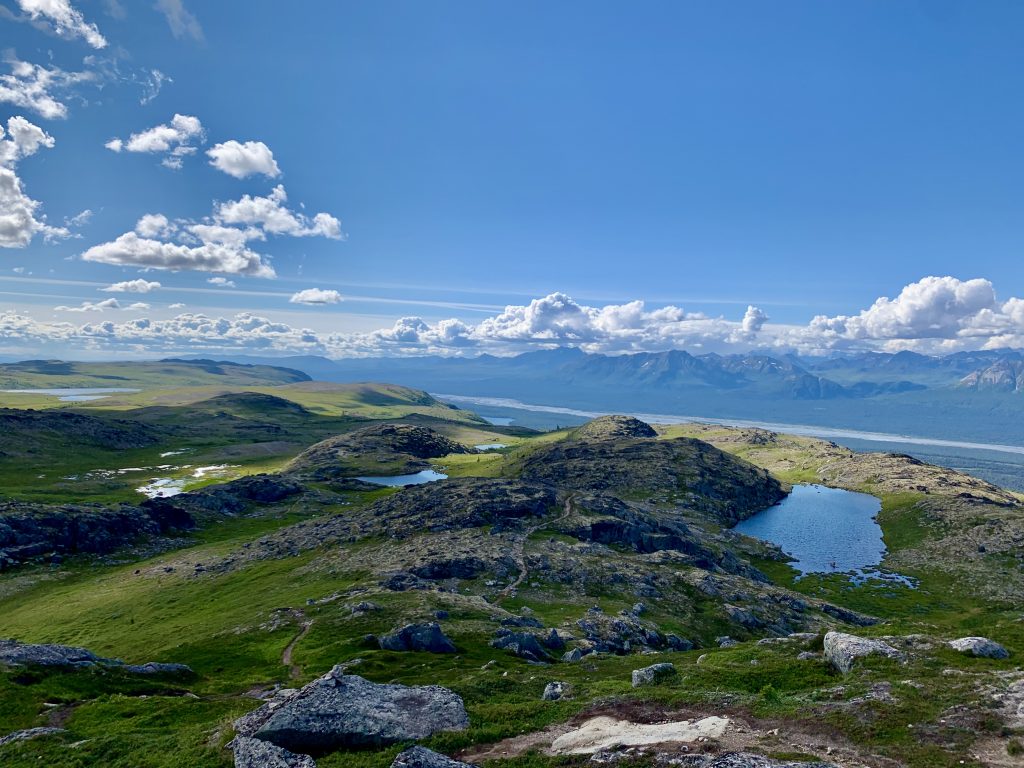
- Miles: 36.2 miles
- Average Nights: 2–3 nights
- Difficulty: Moderate to slightly strenuous
- Overview: The Kesugi Ridge Trail is a stunning ridge line hike that offers panoramic views of Denali and the Alaska Range. It’s a long trail but can be done over a few nights, providing a great mix of challenging sections and scenic landscapes.
Southeast Alaska: Chilkoot Trail
- Miles: 33 miles
- Average Nights: 3–5 nights
- Difficulty: Moderate
- Overview: The Chilkoot Trail follows the historic route of the Klondike Gold Rush. It’s an amazing route where you’ll find discarded pots and pans and strewn horse bones. This multi-day trek takes you through coastal rainforests and over mountain passes. While not the most strenuous, it does require perseverance over the course of a few days.
Southwest Alaska: Valley of Ten Thousand Smokes:
- Miles: 23 miles (one way, with side trails)
- Average Nights: 2–4 nights
- Difficulty: Moderate to Strenuous
- Overview: The Valley of Ten Thousand Smokes is an incredible volcanic landscape, created by the eruption of Novarupta in 1912. This surreal environment, filled with ash-filled valleys and fumaroles, offers a unique and remote backpacking experience. The hike takes you deep into a barren, yet striking, landscape, providing a true sense of isolation and adventure in the Southwest Alaska wilderness
Far North/Arctic Alaska: Brooks Range (Anaktuvuk Pass)
- Miles: Varies depending on the route (typically 20–40 miles)
- Average Nights: 3–5 nights
- Difficulty: Strenuous
- Overview: Starting at Anaktuvuk Pass, this route into the Brooks Range provides one of the most remote wilderness experiences in Alaska. The terrain is rugged and unmarked, and you’ll need strong navigation skills. This is a true backcountry trek, perfect for seasoned adventurers. There are no trails here.
Essential Gear for Backpacking in Alaska
When planning a backpacking trip to Alaska, you better have the right gear. Our unpredictable weather and rugged terrain require durable, high-quality equipment. Below is a list of must-have items to ensure a safe and comfortable journey through the Alaskan wilderness:

Tents
Opt for a 3 or 4-season tent, especially if you’re backpacking in the shoulder seasons or in higher elevations. Alaska’s weather can be unpredictable, with sudden storms and strong winds. A sturdy, waterproof tent with a reinforced frame is key for protecting against the elements. Look for tents with full rain flies and solid ventilation to prevent condensation buildup.
- My Gear: MSR Hubba Bubba tent: This tent is technically a 3-season tent, but it’s known to be very durable and rugged and has served me well in various conditions, offering ample space and excellent weather resistance.
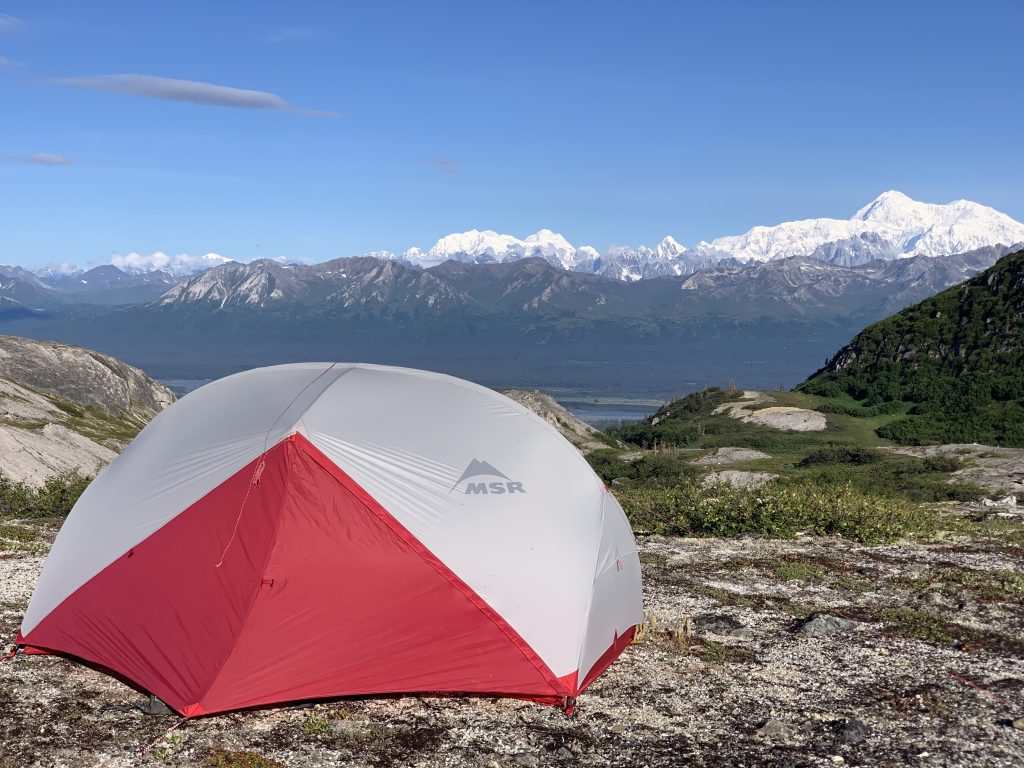
Sleeping Bags
Given Alaska’s cooler climate, even in summer, you’ll want a sleeping bag rated for sub-freezing temperatures. I recommend a down sleeping bag is recommended for its warmth-to-weight ratio, but synthetic options are available for wet conditions. A sleeping bag with a comfort rating of 0°F to 20°F is ideal for most Alaska trips.
Sleeping Pads
Insulation from the cold ground is just as important as insulation from the air. A high-R-value sleeping pad (R-value of 4 or more) will provide necessary insulation, especially for colder nights.
- My Gear: I currently use the discontinued Big Agnes Air Core Ultra (R-value of 4.5). A similar option is the Big Agnes Zoom UL Insulated, which offers great comfort and insulation for a good night’s sleep.
Footwear
While many hikers opt for high-ankle boots, it’s a hotly debated topic within the backpacking community. Some find trail runners work just fine! A key tip: I recommend avoiding GORE-TEX footwear, as your feet will likely get wet. Instead, choose footwear that can dry quickly.
- My Gear: I love barefoot shoes and go with the Vivo Tracker hiking boots.
Clothing
Layering is critical. Start with a moisture-wicking base layer made of merino wool or synthetic material. Add a warm mid-layer, such as a fleece jacket or down jacket, and top it off with a waterproof, breathable outer shell. Alaska’s weather can change rapidly, so it’s important to be prepared for rain, wind, and cold. Definitely bring rain gear: a high-quality rain jacket and rain pants are essential.
- Pack extra socks and a hat for colder nights.
- My Gear:
- Base Layer: Smartwool Classic Thermal Merino Base Layer 1/4 Zip
- Insulation Layer: Rab Electron Pro Down Jacket
- Rain Jacket: My go-to is the discontinued Mammut Teton HS Hooded Jacket, but the current equivalent is the Mammut Nordwand Pro HS Hooded Jacket.
- Rain Pants: I use the Mammut Alto Light HS Pants
- Socks: Darn Tough Socks or nothing
- My Gear:
Backpacks
Choose a backpack that’s comfortable and fits well, with enough capacity for multi-day trips (around 60-70 liters). A waterproof backpack cover or dry bags are essential to keep your gear dry in Alaska’s frequent rain.
- My Gear: Gregory Baltoro 75: This pack is spacious and provides great support for carrying all my gear. I’m not an especially light packer and plus, I need a lot of room for food.
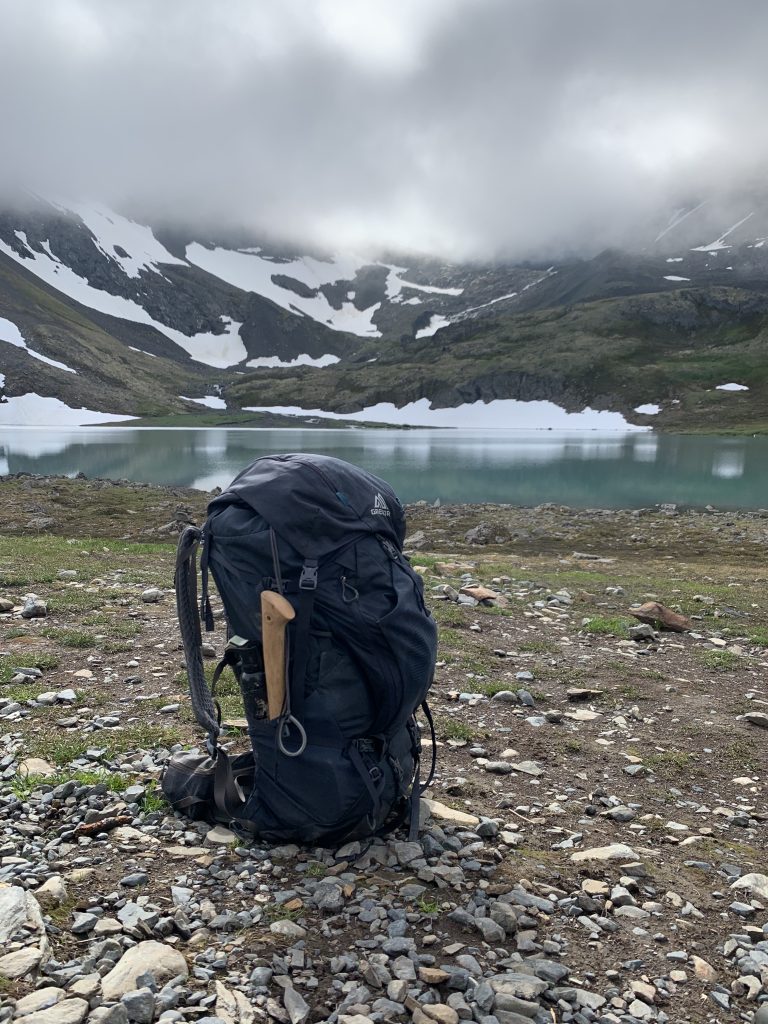
Water Filtration System
Alaska’s rivers and streams are generally clean, but you should still filter or purify your water. A lightweight water filter or purification tablets are both good options. Make sure you always have access to safe drinking water, especially in remote areas.
- My Gear: The Sawyer Squeeze: A reliable and lightweight option for ensuring clean drinking water on the trail.
Cooking Gear
A lightweight stove, such as the MSR PocketRocket or Jetboil, is ideal for boiling water and cooking freeze-dried meals. Bring enough fuel for the duration of your trip, as resupplying can be difficult. Don’t forget a lightweight pot, spork, and windshield for your stove.
- My Gear: I use a Pocket Rocket stove paired with the Sea to Summit Frontier Ultralight Cook Set for easy meal preparation.
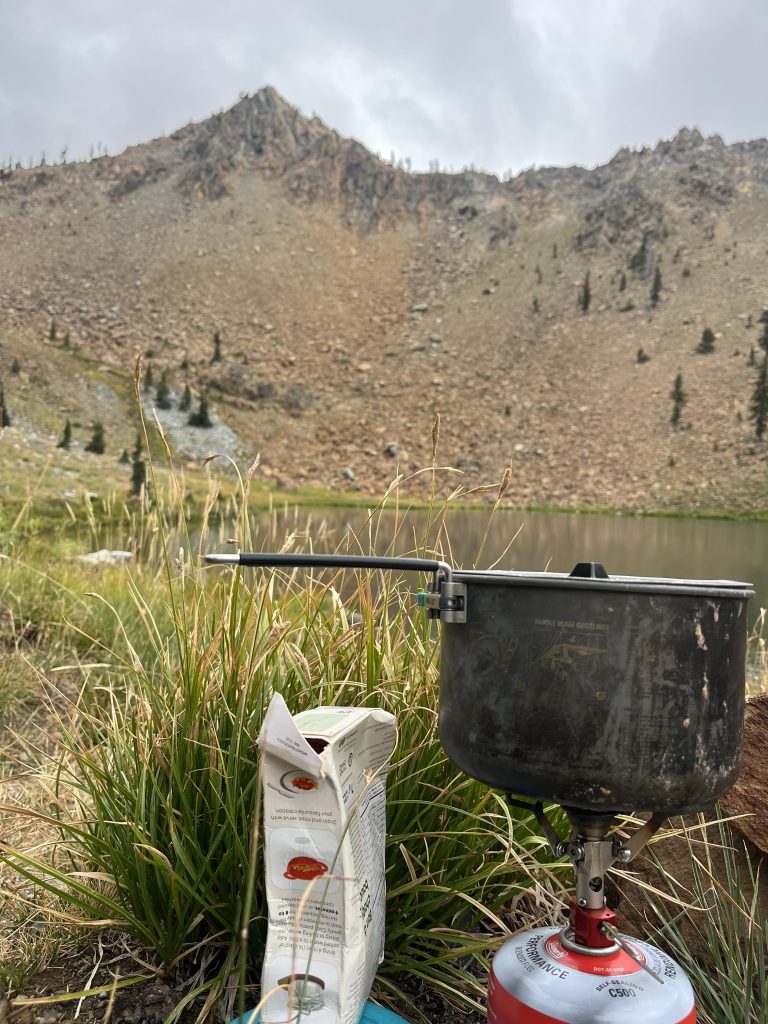
Navigation Tools
Carry a topographic map and compass for navigating remote trails, and consider a GPS device or satellite communicator, such as a Garmin inReach, especially for longer trips. Many trails in Alaska are unmarked, so navigation skills are important.
First Aid Kit
Pack a comprehensive first aid kit, including bandages, antiseptic, pain relievers, and any personal medications. Alaska’s remote wilderness means you could be far from medical assistance, so it’s important to be prepared for minor injuries.
Bear Safety Gear
Bear spray is a must in Alaska. Additionally, a bear-proof container for food storage is often required in bear country. Make sure to store food away from your campsite to avoid attracting wildlife.
- My Gear: Sometimes, I opt for an Ursack bear bag, which is lighter and more convenient than traditional hard-sided containers. While some recommend hard-sided containers for their durability, I find them cumbersome to carry.
Miscellaneous Gear
- Headlamp: Even in summer, you’ll need a headlamp for early mornings or cloudy days.
- My Gear: The Storm 500-R Rechargable Headlamp
- Sunscreen and bug repellent: Alaska’s summer sun can be harsh, and mosquitoes can be relentless.
- Mosquito net for your head
- Trekking poles: These are helpful for maintaining balance on rugged terrain or steep ascents and descents.
Wildlife Safety While Backpacking in Alaska
Alaska is home to a variety of wildlife, including bears, moose, and wolves. While these animals are an incredible part of the Alaskan experience, it’s crucial to take precautions to ensure your safety and the safety of the wildlife.
Bear Safety
Bears are the most common concern for backpackers in Alaska, especially in areas with heavy salmon runs. Always carry bear spray and know how to use it. Always make noise while hiking to avoid startling a bear, particularly in dense brush or when visibility is limited. If you see a bear, never approach it, and if you encounter one, remain calm and back away slowly. It’s important to store food in bear-proof containers like an Ursack or a hard-sided container, depending on regulations for the area you’re visiting. Never store food in or around your tent and, if you want to be extra careful, eat far away from your sleeping area.
That said, in 29 years of Alaskan adventures, I’ve never had a bad encounter with a bear. I never travel with a gun and have never had to use bear spray. Just be smart.
Moose Encounters
Moose are surprisingly more dangerous than bears due to their size and unpredictable nature. They kill more people per year than bears. They can charge if they feel threatened, especially during the rutting season in fall or if they are protecting calves. Keep your distance and be mindful of their body language—ears back or raised hair can be signs of aggression. Give moose plenty of space and do not attempt to pass one on a trail unless it has moved a safe distance away.
Food Storage
Following Leave No Trace principles is critical for managing wildlife safety. Store all food, trash, and scented items in bear-resistant containers or hang them at least 100 feet away from your campsite. In some regions, the use of bear-proof containers is mandatory, especially in places like Denali National Park.
Camp Safety
Never cook or store food near your tent. A good rule of thumb is to keep your cooking area and food storage area at least 100 feet away from your campsite. Always clean up food scraps, and never leave food unattended, even during meal preparation. Cooking odors can attract not just bears but other wildlife as well.
Using Bear Spray
Bear spray is your first line of defense against bear encounters. Practice using it before you head out, so you’re familiar with how to deploy it quickly in an emergency. If a bear charges, aim just below its head, and discharge the spray when the bear is within 30 feet. And then get the F out of there.
Navigating Alaska’s Wilderness: Maps, GPS, and Survival
Alaska’s backcountry is vast, remote, and often unmarked, making navigation and survival skills essential for safe travel. Whether you’re relying on a map or modern GPS devices, knowing how to stay warm and dry is just as important as knowing your route.
Even well known trails often feature parts that are difficult to navigate, either due to erosion, fog, or high alpine rocks where no trails can be marked.
Maps and Compass
Always carry a topographic map and a compass. Alaska’s wilderness areas often lack trail signage, so knowing how to read and orient a map is vital. A compass will ensure you stay on track, even when the trail fades or disappears.
GPS Devices and Satellite Communicators
In areas with no cell service, a GPS device or satellite communicator is invaluable. Devices like the Garmin inReach allow for GPS navigation and emergency communication. These are excellent backups, but they should never replace your map and compass skills. You can rent these in Anchorage.
Wayfinding in Alaska’s Wilderness
In some areas, there are no marked trails, so learning to navigate by natural landmarks—such as ridgelines, rivers, and valleys—is essential. Be prepared to rely on your own skills in the most remote parts of the state. Follow the cairns!

Cotton Kills
I grew up with my dad always telling me that “cotton kills.” Cotton absorbs moisture, whether it’s sweat, rain, or humidity, and dries incredibly slowly. Once wet, it loses all its insulating properties and can lead to rapid heat loss, putting you at risk of hypothermia—even in relatively mild conditions.
- Why Cotton is Dangerous: In Alaska’s variable weather, staying dry is essential. Cotton clothing traps moisture against your skin, cooling you down as the moisture evaporates. In cold or windy conditions, this process can be life-threatening as your body loses heat faster than it can generate.
- What to Wear Instead: Opt for synthetic fabrics or merino wool, which wick moisture away from the skin, dry quickly, and continue insulating even when wet. Merino wool, in particular, is highly regarded for its odor resistance and comfort over long hikes. Always leave cotton behind when packing for the backcountry.
Stay Warm. Don’t Try to Warm Up
One of the best strategies for staying comfortable—and safe—in Alaska’s wilderness is to focus on preventing yourself from getting cold in the first place. Once you’re cold, it can be incredibly difficult to warm up, especially in a wet or windy environment. If you stop for a bit on your hike, throw on an extra layer BEFORE you get cold!
- Layering is Key: Start with a moisture-wicking base layer, such as merino wool or synthetic fabrics, to pull sweat away from your skin. Add an insulating mid-layer, like a down jacket or fleece, to retain heat. Top it off with a windproof and waterproof shell to protect against the elements.
- Avoid Sweating: One of the biggest challenges in Alaska’s cold weather is managing sweat. If you’re working hard and start to sweat, stop and remove a layer before you become too wet. Your goal is to avoid sweating, as wet clothing will chill you quickly once you stop moving.
- Keep Your Extremities Warm: Pay attention to your head, hands, and feet, which are the first areas to lose heat. Bring extra hats, gloves, and socks. Cold feet can chill your entire body, so always carry dry socks to change into at camp.
- Eat and Stay Hydrated: Eating calorie-dense foods and staying hydrated will keep your body fueled and able to generate heat. Hot drinks are a great way to warm up from the inside.
Alaska Backpacking Permits and Free Camping
Alaska is a backpacker’s dream when it comes to wilderness access, offering plenty of opportunities for both free camping and areas that require permits. Once you go Alaska, you’ll never go back. Knowing which areas have regulations and which allow for more freedom can help you plan your trip efficiently and avoid any last-minute surprises.
Where Permits Are Required
While much of Alaska’s wilderness is accessible without permits, certain popular or sensitive areas do require them:
- Denali National Park: Backcountry permits are required for overnight backpacking in Denali. The park uses a quota system to limit the number of visitors in each backcountry unit, helping preserve the environment and reduce wildlife disturbance. Permits are issued on a first-come, first-served basis, and bear-resistant food containers are mandatory in most areas.
- Katmai National Park: If you’re camping near Brooks Camp, a permit is required. This area has strict regulations due to the high number of brown bears, and visitors must follow specific bear safety rules. Permits are generally not needed for other areas, like the Valley of Ten Thousand Smokes, unless you plan on overnight camping.
- Public-Use Cabins (Statewide): In both state and national parks, public-use cabins require a reservation in advance. These cabins, which are often in remote locations, are popular and book up quickly, especially in summer.
- Some State Parks: While most state parks don’t require permits for general backpacking, certain areas like Kachemak Bay State Park may require reservations or permits for camping in designated spots. Check with the specific park’s website or visitor center for details.
Where You Can Free Camp
One of the best parts about backpacking in Alaska is the ability to free camp on much of the land. Here are some general guidelines for where you can set up camp without a permit:
- Most State Parks: Outside of heavily regulated or designated camping areas, you can generally free camp in state parks, provided you follow Leave No Trace principles and keep your distance from established trails and water sources.
- National Forests, Tongass National Forest, and Chugach National Forest allow for dispersed camping, meaning you can set up camp nearly anywhere without needing a permit. As always, follow bear safety protocols and avoid sensitive wildlife areas.
- BLM Land: Much of Alaska’s Bureau of Land Management (BLM) land is open for dispersed camping, meaning you can camp almost anywhere for free. This includes vast stretches of wilderness and some of the most remote areas in the state.
- Remote Areas: In areas like the Brooks Range or Gates of the Arctic National Park, there are no established trails or campgrounds, meaning you are free to set up camp where you please. Keep in mind that these areas are incredibly remote and require a high level of self-sufficiency.
Bear Safety and Regulations
Even in areas where permits aren’t required, bear safety rules often apply. In much of Alaska, particularly where brown bears are present, bear-resistant containers or food lockers are required to protect both visitors and wildlife. Always check the specific park or area regulations before you head out.
Leave No Trace Guidelines
In all areas, whether free camping or staying in a designated campground, Leave No Trace principles are crucial. Pack out all trash, minimize campfire impact, and respect wildlife by keeping your distance.
Two-Week Alaska Backpacking Itinerary
Given Alaska’s distance and vastness, we highly recommend spending at least two weeks to make the most of your backpacking adventure. This itinerary is based out of Anchorage, featuring two incredible backpacking trips along with some well-deserved downtime. In reality, you really should come for at least a month.
This itinerary is for those who are looking to complete two epic backpacking trips, while still getting to explore Anchorage a bit. You can also explore several other itineraries we’ve designed.
Day 1–2: Arrival in Anchorage
- Arrive in Anchorage: Use these first two days to settle in and explore the city. Check out local attractions like the Anchorage Museum or take a leisurely stroll along the Tony Knowles Coastal Trail.
- Optional Day Trip: If you have extra time, I highly consider taking a short hike to Flattop Mountain or take a drive south along the Seward Highway for scenic views.
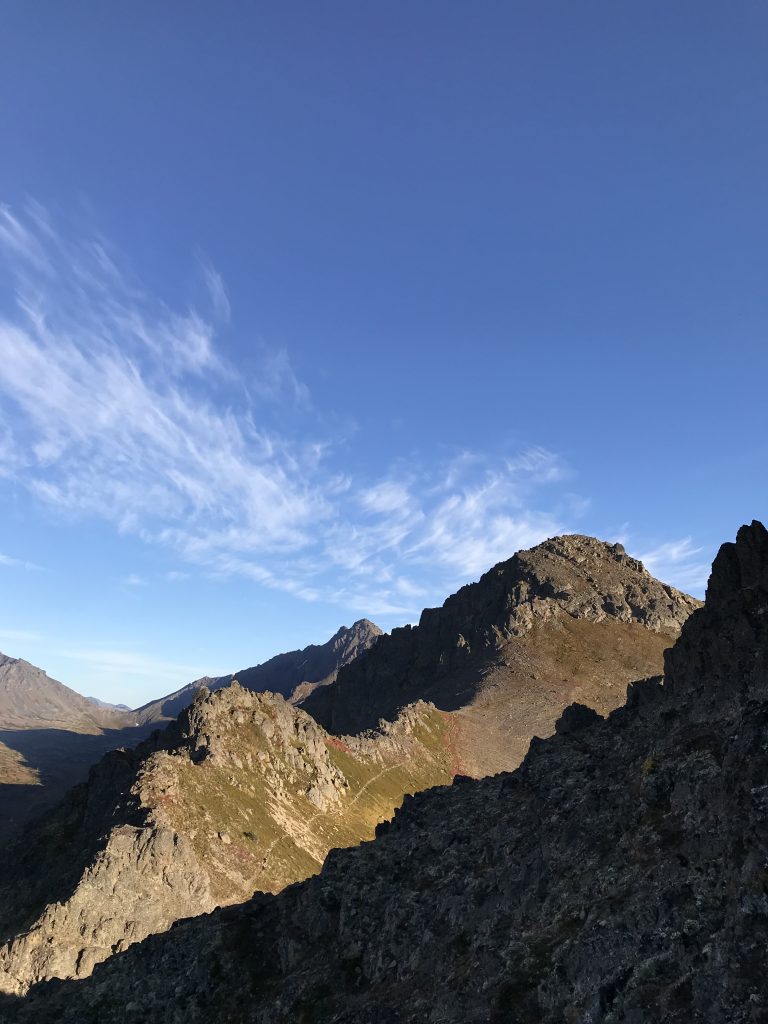
Day 3–7: Kesugi Ridge Backpacking Trip (4–5 Days)
- Drive to Denali State Park (Day 3): About a 2.5-hour drive from Anchorage, start your first major backpacking trip on the Kesugi Ridge Trail. This 36-mile trek offers breathtaking views of Denali and expansive alpine terrain. This isn’t a loop, so you’ll have to hitch your way back.
- Backpacking Days (Day 4–6): Spend 3 days hiking this ridge with stunning mountain views, wildflower meadows, and wildlife sightings. Plan for some elevation gain but be rewarded with panoramic vistas.
- Return to Anchorage (Day 7): After your hike, head back to Anchorage, and unwind with some of the best pizza you’ll ever have at Moose’s Tooth, enjoying their signature craft beers and legendary pizza.
Day 8–9: Rest Days and Explore Anchorage
- Rest and Recover: After your first backpacking trip, take a couple of days to recover and explore Anchorage’s vibrant food and culture scene. Visit hike out to Symphony Lakes, check out Rabbit Lake, bag Big O’Malley Peak, and enjoy some local breweries.
- Pizza at Moose’s Tooth: If you didn’t already, you’ll want to stop by Moose’s Tooth Pub & Pizzeria, one of Anchorage’s top spots for craft beer and pizza. The local vibe and relaxed atmosphere are perfect for unwinding after a day of exploring.
Day 10–14: Bomber Glacier Traverse (5 Days)
- Drive to Hatcher Pass (Day 10): Start your second backpacking trip at Hatcher Pass, about 1.5 hours from Anchorage. Begin the Bomber Glacier Traverse, a 24-mile loop through rugged terrain, including glacier crossings and stunning alpine lakes.
- Backpacking Days (Day 11–13): The Bomber Glacier Traverse is a challenging route but offers unforgettable views of Mint Glacier Hut and the Bomber Glacier, along with a thrilling adventure through Alaska’s remote wilderness. I highly recommend doing it the long way, which few people do and hitting Dnigi Hut, Holden Hut (my favorite cabin in the world), and then Bomber Hut.
- Return to Anchorage (Day 14): After completing the traverse, head back to Anchorage for your final night. Celebrate your successful adventure and the Spenard Roadhouse for some delicious sweet potato tater tots and other good food!
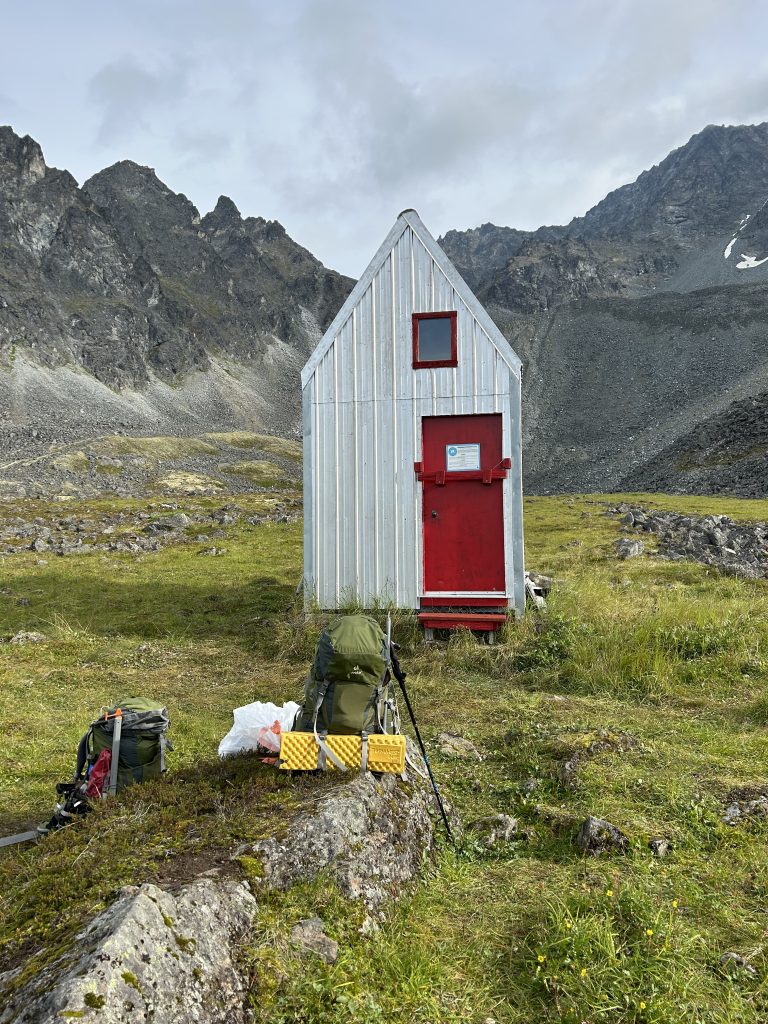
Additional Notes
- Weather and Timing: July and early August are ideal times to visit Alaska, when trails are free of snow, and mosquitoes are less of a nuisance.
- Rest Days: Plan for rest days between your backpacking trips to avoid burnout and enjoy the sights Anchorage has to offer.
Our Top 10 Little-Known Tips About Alaska
- Free Bear Spray: Since you can’t fly with bear spray, many travelers give it away at the end of their trips. Check out local groups like this Facebook group to score free bear spray instead of purchasing your own.
- Affordable Car Options: Rental car prices in Alaska can be sky-high during summer. Instead, consider renting or even buying a car off Craigslist. You can find some great deals that will save you money.
- Best Time to Visit: In our opinion, early August is the ideal time to visit Alaska. The weather is generally favorable, and mosquito activity starts to decrease.
- Free Mountaineering Huts: The Talkeetna Mountains are home to incredible mountaineering huts that you can stay in for free (with a small membership fee to the Mountaineering Club of Alaska). These huts offer a rustic, adventurous experience you won’t forget.
- Avoid Gortex Hiking Boots: Gortex may seem ideal, but in Alaska, your feet are bound to get wet. It’s better to wear boots that dry quickly rather than relying on waterproof gear that might leave you with damp, cold feet.
- Consider Packrafting: Alaska’s rivers, lakes, and coastlines make it a packrafting paradise. If you’re up for an epic experience, packrafting is a unique and exhilarating way to see Alaska’s landscapes.
- Kesugi Ridge Over Denali: If you want stunning views without the crowds of Denali, try hiking Kesugi Ridge instead. It offers panoramic views and a more secluded experience.
- Check Mosquito Conditions: Alaska’s mosquitoes are notoriously intense and can ruin a trip if you’re not prepared. Always bring a mosquito net and check the severity of mosquito activity before your arrival.
- Be Prepared for Remote Conditions: Many trails and parks in Alaska are extremely remote, so always have a backup plan and enough supplies in case of delays or emergencies.
- Pack Extra Layers: Alaska’s weather is unpredictable, even in summer. Extra layers, especially ones that dry quickly, will make a big difference if conditions change unexpectedly.
My Top Five Favorite Places in Alaska (Off the Beaten Track)
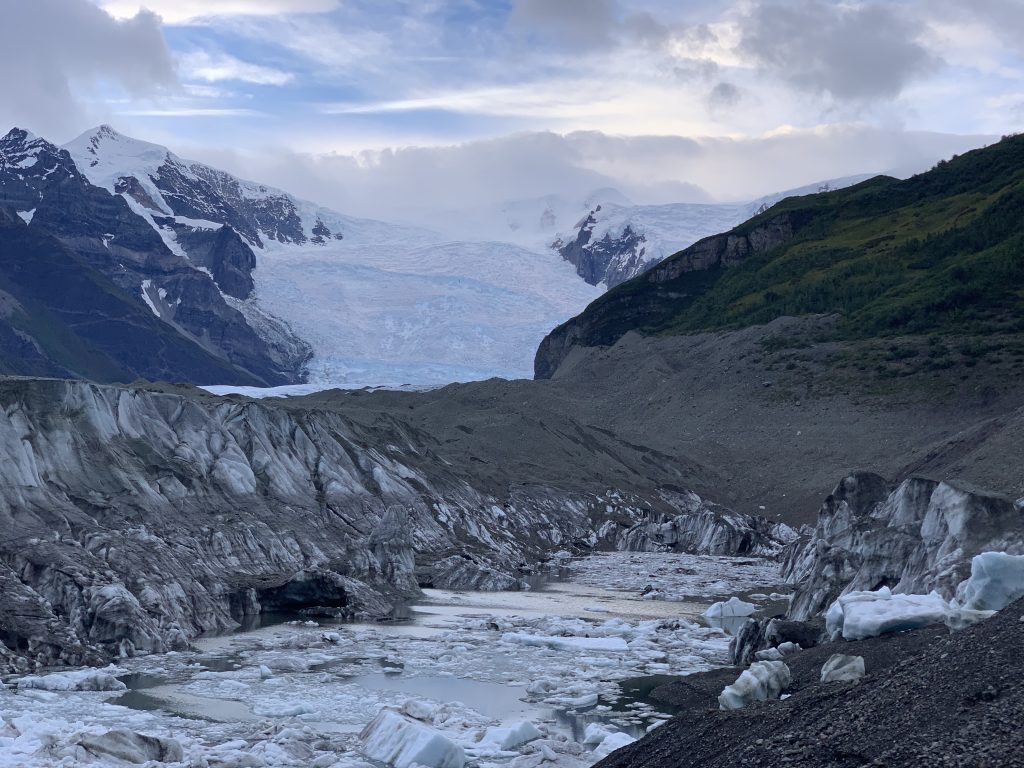
- Hatcher’s Pass: Just north of Anchorage, Hatcher’s Pass is surrounded by incredible mountains and features an old gold mine that you can explore. Stay at the cozy Hatcher’s Pass Lodge for affordable, scenic lodging with a sauna. If you’re not staying, at least visit the lodge, which was originally homesteaded by a local legend who passed away last year.
- The Bomber Traverse: One of the most thrilling multi-day hikes in Alaska. The Bomber Traverse, located in the Talkeetna Mountains, takes you through glacier fields and past an old WWII bomber crash site. It’s a challenging but rewarding route. If it sounds too intense, consider hiking to the Reed Lakes for a less demanding adventure (more info).
- McCarthy and Kennicott Glacier: Accessible only by footbridge, McCarthy is a quirky, artsy town near the Kennicott Glacier. It’s a fascinating place with a unique history and some of Alaska’s most impressive glacier views. The glacier itself resembles the famous Wall from Game of Thrones—an unforgettable sight.
- Seldovia and Halibut Cove: Head down to Homer, then take a boat across the bay to Seldovia. Homer is known for its boardwalk, beaches, and vibrant local scene, while Seldovia and Halibut Cove offer a quieter, more scenic escape. Halibut Cove is pricey but beautiful for a day trip, while Seldovia has plenty of affordable accommodations.
- Chugach Peaks: Just a short drive from Anchorage, the Chugach Mountains are like a backyard playground with countless peaks, ridges, and lakes. My favorite hikes here are McHugh Peak and Big O’Malley. It’s easy to spend an entire summer exploring this range without seeing the same view twice.
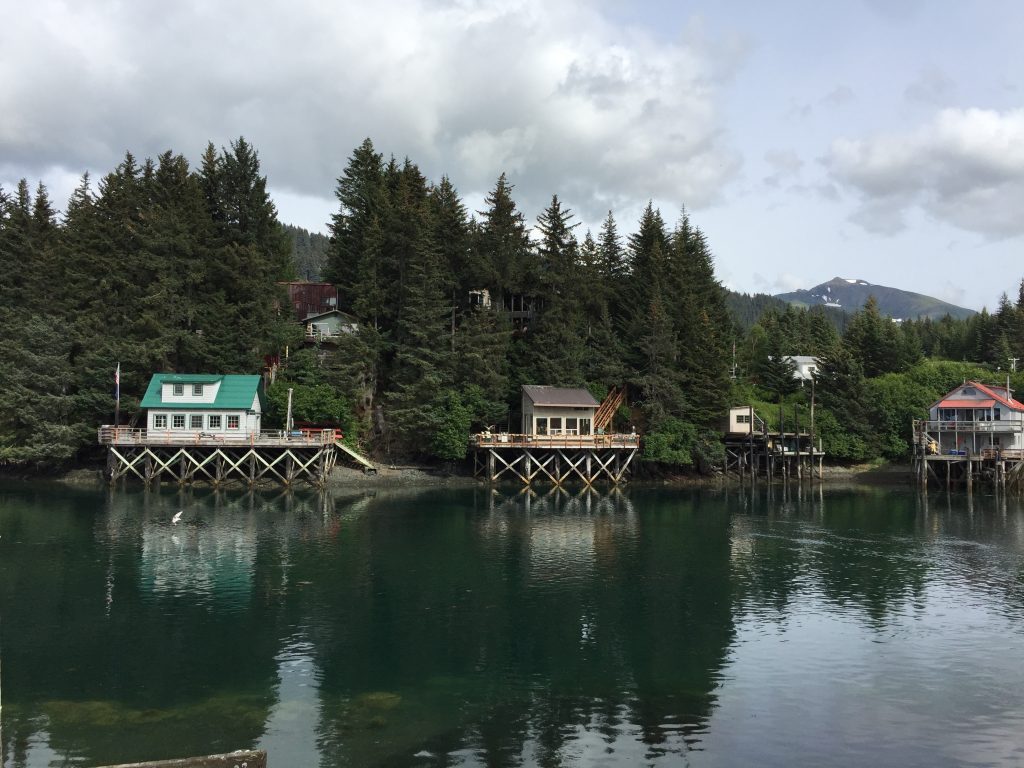
Conclusion: Your Unforgettable Alaskan Adventure Awaits
Backpacking in Alaska is a journey into one of the world’s last great wildernesses, offering breathtaking landscapes, rugged trails, and experiences you’ll remember for a lifetime. From the expansive tundra of the Arctic to the lush rainforests of Southeast Alaska, every region has something unique for adventurers to explore. As you plan, keep in mind the essentials—choosing the right season, packing the appropriate gear, and practicing wildlife safety. Alaska’s wilderness can be both awe-inspiring and unforgiving, but with preparation and respect for the land, your trip will be rewarding beyond words.
